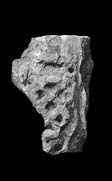Select a site alphabetically from the choices shown in the box below. Alternatively, browse sculptural examples using the Forward/Back buttons.
Chapters for this volume, along with copies of original in-text images, are available here.
Object type: Fragment of grave-cover
Measurements: H. 28 cm (11 in) W. 17 cm (6.75 in) D. 18 cm (7 in)
Stone type: Pale brownish-grey (10YR 8/4) oolite, of 0.5 to 0.6 mm ooliths and 1 mm pellets, with few but large recrystallised shell fragments. Ooliths for the most part close-set, but there are patches with only sparsely scattered ooliths in a pale greyish brown (10YR 7/1–3) silty, micritic matrix. Cathedral Beds, Lower Lincolnshire Limestone, Inferior Oolite Group
Plate numbers in printed volume: Fig. 14; Ill. 174
Corpus volume reference: Vol 5 p. 168
(There may be more views or larger images available for this item. Click on the thumbnail image to view.)
A small fragment from near one end of a flat, rectangular or slightly tapering grave-cover of Lindsey type decorated in low relief and only on the upper surface.
A (top): The inner edge of a border survives near one edge of the stone and has the hint of a diagonal incision that indicates that it was cable-decorated. In the central panel a single unit of simple pattern F interlace survives, probably part of a repetitive figure-of-eight pattern. The unit measures 15 × 10cm (6 × 4 in). A strand emerging from one end of the unit turns across the stone, curving in preparation to turn into the next parallel row of interlace and thus forming the closed end of the pattern. The decoration stands sharply as a squared U section against the flat cut-away background. In addition to casual damage, this face has a longitudinal secondary groove of square section, about 3cm deep and at least 2cm wide, along which the stone has been split. There are two modern drill holes.
B (long) and C (end): Both have sections of straight dressed surface, that on face B weathered and with lichen growth showing that it was an exposed surface in the secondary use. These surfaces are at right angles to each other but askew to the lie of the pattern and therefore are secondary rather than original faces.
D (long) and E (end): Broken.
F (bottom): A small area of dressed surface indicates original thickness of cover.
This is a fragment of an interlaced cover of Lindsey type discussed in Chapter V. Even in its fragmentary and damaged state, the characteristic basis of decoration, fine-quality stone and execution are distinctive. The unit size of the figure-of-eight is close to the norm on large covers of this type and the spacing was clearly not cramped. The method of closing the pattern is the same as on Laceby 1, Lincoln St Mark 4, Manby 1, Miningsby 1, Northorpe 1, Stow 2 and Tathwell 1 (see Fig. 14). The recutting for secondary use and recent damage do not allow certainty whether the cabled border was single or double. The longitudinal groove may be scoring for splitting for secondary use (cf. Lincoln St Mark 16, Northorpe 1 and Theddlethorpe 1).



